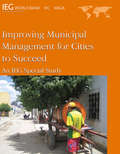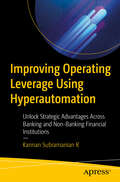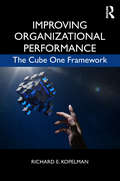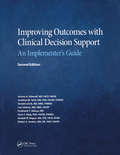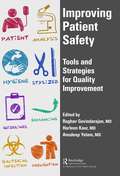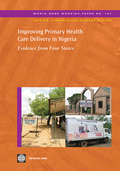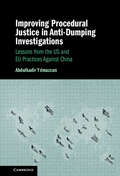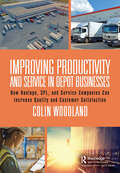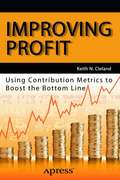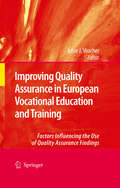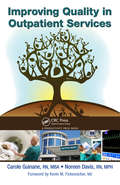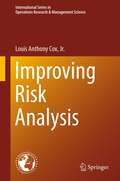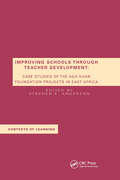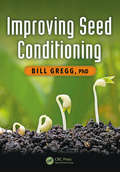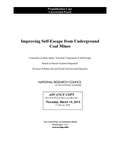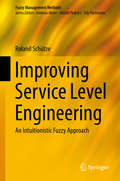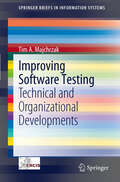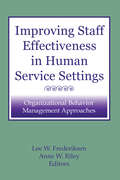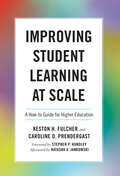- Table View
- List View
Improving Managerial Talent: Practical Psychology for Human Resourcing and Learning & Development Professionals
by Hugh McCredieAimed at senior HRM and L&D specialists responsible for improving their organisation’s managerial talent, Improving Managerial Talent covers the core findings of the author’s and other published research. It provides a highly participative overview of personality and ability psychometrics, involving the opportunity for self-application. It reveals hard evidence of the extent to which such tests can add value to the prediction of managerial success and their link to requisite competencies. It shows how qualified testers, HR and line managers can each make a unique contribution to the selection process. The book goes on to show how management style is a product of personality and habit and how the acquisition and use of a complementary style can improve persuasiveness and the cultivation of interpersonal skill both for the manager and for those whom the manager might need to coach. It regards job-challenge as the primary engine of managerial growth, both for development in key result areas and for underlying personal competencies. The book provides the reader with some self-insights and an appreciation of validated, powerful, often in-house, methods for selecting and developing better managers. The methods on offer have been validated on a population of over 400 directors of small to medium-sized business units. They include a generic psychometric algorithm for the selection of managers, some unique findings on styles of managing, coaching and persuading based upon close observation of over 200 senior managers and a distinctive and powerful approach to developing interpersonal skills by (1) practice, (2) demonstration of alternatives and (3) reflection.
Improving Municipal Management for Cities to Succeed
by Independent Evaluation Group, World BankCities now house half the world's population and produce 70 percent of its GDP. Managing them well helps development. Strengthening municipal management of planning, finance, and service provision has been at the core of World Bank support through municipal development projects (MDPs). This book reviews how, worldwide, nearly 3,000 municipalities have benefitted from 190 World Bank-supported MDPs over the past decade, three quarters of which achieved satisfactory outcomes. The finance dimension of MDPs-computerized accounting, revenue generation, and municipal credit-produced some of the best results, but weaker outcomes came from attempts to stimulate private finance of municipal services. City planning, used by municipalities worldwide, was not a strong priority for MDPs. But building municipal information systems, for example in Chile, were successful. Monitoring and evaluation rarely worked well, except when municipalities themselves were convinced of its usefulness, such as in Russia, Tunisia, and Colombia. Results in managing service provision were mixed. The poverty focus of MDPs was strikingly weak across the portfolio. Cost-benefit analysis rarely prioritized municipal investments. But MDPs helped municipalities strengthen their procurement function. MDPs helped municipalities manage services more effectively. Better results still can come from a stronger poverty focus, more attention to planning and prioritizating investments, and more effective operation and maintenance of such investments.
Improving Operating Leverage Using Hyperautomation: Unlock Strategic Advantages Across Banking and Non-Banking Financial Institutions
by Kannan Subramanian RImproving operating leverage is about operational resilience, structural operational efficiency, and sustainable revenue growth. Activity-based enterprise non-interest cost management is an important component of enterprise risk adjusted return management methodology. This book builds on the author Kannan Subramanian’s earlier book, Event- and Data-Centric Enterprise Risk-Adjusted Return Management, delving in depth into enterprise non-interest operating cost management and operating leverage. Operating Leverage is about managing a bank’s capabilities and its capacity to deliver its products and services efficiently. It is not limited to managing operational costs but includes the operational support for the growth of business and for improving profitability. Profit is an absolute measure that denotes the amount of money the bank makes after deducting all expenses. Profitability measures how efficient the bank is at utilizing its resources to generate risk-adjusted returns. The reader can learn to improve risk adjusted operational effectiveness by implementing a nuanced approach to managing performance, risk, control, and cost simultaneously, at the process level. You’ll examine how some institutions have implemented activity-based costing in a siloed environment and without enterprise process automation. Many institutions do not have a scientific way of managing non-interest costs. The book explains why hyperautomation, a technology that intelligently automates business processes, is a more advanced and comprehensive way to manage these factors in a holistic and integrated way. Improving Operating Leverage using Hyperautomation is your complete guide to enhancing risk adjusted operational performance through a nuanced approach to performance, risk, control, and costs at the process level. What You Will Learn Define and use the bill of resources to improve operating leverage. Implement activity-based enterprise non-interest cost management using hyperautomation Monitor performance, risk, control, and cost at the process level. Implement time-driven activity-based costing for an enterprise risk-adjusted return model. Who This Book Is For Most banking industry professionals, including senior management teams, consultants, central bankers, financial regulators, software vendors, and Business Process Management Suite/Hyperautomation technology vendors.
Improving Organizational Performance: The Cube One Framework
by Richard E. KopelmanThis book presents the Cube One framework, which provides a basis for understanding, diagnosing, and improving organizational performance. It is based on the premise that successful organizations enact practices that satisfy three key constituents: the enterprise itself, customers, and employees. This book offers a uniquely empirical approach by examining enterprise-, customer-, and employee-directed practices. Validity evidence is provided by survey research, studies of financial metrics, and the analysis of cases involving well-known organizations (such as Google, Four Seasons, and Mayo Clinic). The Cube One framework is equally applicable to organizations in the for-profit, nonprofit, and government sectors. After reading this book, students and scholars, as well as organizational practitioners in the fields of organizational behavior and management, will find a practical approach to improving organizational performance.
Improving Outcomes with Clinical Decision Support: An Implementer's Guide, Second Edition (HIMSS Book Series)
by Jerome. A Osheroff Jonathan M Teich Donald Levick Luis Saldana Ferdinand Velasco Dean F Sittig Kendall M Rogers Robert A JendersWinner of the 2012 HIMSS Book of the Year Award! Co-published by HIMSS, the Scottsdale Institute, AMIA, AMDIS and SHM, this second edition of the authoritative guide to CDS implementation has been substantially enhanced with expanded and updated guidance on using CDS interventions to improve care delivery and outcomes. This edition has been reorganized into parts that help readers set up (or refine) a successful CDS program in a hospital, health system or physician practice; and configure and launch specific CDS interventions. Two detailed case studies illustrate how a "real-life" CDS program and specific CDS interventions might evolve in a hypothetical community hospital and small physician practice. This updated edition includes enhanced worksheets--with sample data--that help readers to document and use information needed for their CDS program and interventions. Sections in each chapter present considerations for health IT software suppliers to effectively support their CDS implementer clients.
Improving Patient Safety: Tools and Strategies for Quality Improvement
by Raghav GovindarajanBased on the IOM's estimate of 44,000 deaths annually, medical errors rank as the eighth leading cause of death in the U.S. Clearly medical errors are an epidemic that needs to be contained. Despite these numbers, patient safety and medical errors remain an issue for physicians and other clinicians. This book bridges the issues related to patient safety by providing clinically relevant, vignette-based description of the areas where most problems occur. Each vignette highlights a particular issue such as communication, human facturs, E.H.R., etc. and provides tools and strategies for improving quality in these areas and creating a safer environment for patients.
Improving Performance: How to Manage the White Space on the Organization Chart
by Geary A. Rummler Alan P. BracheImproving Performance is recognized as the book that launched the Process Improvement revolution. It was the first such approach to bridge the gap between organization strategy and the individual. Now, in this revised and expanded new edition, Gary Rummler reflects on the key needs of organizations faced with today's challenge of managing change in today's complex world. The book shows how to apply the three levels of performance and link performance to strategy, move from annual programs to sustained performance improvement, redesign processes, overcome the seven deadly sins of performance improvement and much more.
Improving Primary Health Care Delivery in Nigeria
by World BankThis paper, based on quantitative surveys at the level of primary health care facilities, health care personnel, and households in their vicinity, aims at understanding the performance of primary health care providers in four states in Nigeria. As possible ways to improve performance, the paper concludes that clearly defining lines of responsibility, implementing performance-based financing of local governments and providers, and collecting, analyzing, and sharing information are some options that can help realign incentives and improve accountability in the service delivery chain and service provision. This working paper was produced as part of the World Bank's Africa Region Health Systems for Outcomes (HSO) Program. The Program, funded by the World Bank, the Government of Norway, the Government of the United Kingdom, and the Global Alliance for Vaccines and Immunization (GAVI), focuses on strengthening health systems in Africa to reach the poor and achieve tangible results related to Health, Nutrition, and Population. The main pillars and focus of the program center on knowledge and capacity building related to Human Resources for Health, Health Financing, Pharma-ceuticals, Governance and Service Delivery, and Infrastructure and ICT.
Improving Procedural Justice in Anti-Dumping Investigations: Lessons from the US and EU Practices Against China
by Abdulkadir YilmazcanBy synthesizing both theoretical and empirical insights, this book offers a distinctive perspective on procedural justice within the context of anti-dumping investigations. The book highlights the disjunction between the provisions outlined in the World Trade Organization's Anti-Dumping Agreement (ADA) and the practical encounters faced by stakeholders such as exporters, regulatory bodies, and legal experts affiliated with the WTO. Employing a mixed-method approach, the research encompasses a comprehensive doctrinal analysis of procedural complexities alongside empirical investigations involving key stakeholders such as WTO legal experts, Chinese exporters, and investigating authorities. Furthermore, this book underscores the potential for enhancing procedural justice through either a comprehensive reform of the ADA or concrete measures such as a standardized anti-dumping questionnaire. Such improvements offered in the book have the potential to curtail the misuse of anti-dumping investigations, consequently mitigating a substantial number of disputes that might be brought before the WTO's Dispute Settlement Mechanism.
Improving Productivity and Service in Depot Businesses: How Haulage, 3PL, and Service Companies Can Increase Quality and Customer Satisfaction
by Colin WoodlandThis book is specifically for working operations managers across the broad range of business types that deploy fleet and product via a myriad of service types. It is applicable to businesses with small medium to large fleets in haulage, 3PL, and any service business operating a depot structure. The book is less about theoretical concepts – although specific references point to theories including Lean, continuous improvement, net promoter score, and balanced scorecard – but is essentially a practical guide applying worked examples and generic templates regarding the core ten activities that are critical to achieving service and profit expectation in any depot, route-based business deploying fleet. Every working manager – front-line to COO – will identify with and grasp that these are fundamental areas and that, if improvement can be sustained, will deliver better service to customers and enhanced profit in both local and business levels. The key areas examined are: People management Fleet management Route scheduling Optimisation of non-productive (on-depot) time Driver debrief Customer service and complaint management and measurement Key performance indicators The operating rhythm Continuous improvement
Improving Profit
by Keith N. ClelandBusiness of all sizes have a problem: How do you know--in real time--whether you are earning the profit you need to grow or even just stay in business? And which products or services are doing the "heavy lifting" in contributing to profit? Financial statements tell only part of the story. They are backward looking, for one thing, and they generally show results only in the aggregate. Worse, they never seem to reflect the hard work you''re doing on a daily basis. As one manager said, "If I''m adding 25% profit to every job, why am I getting barely 5% net profit at the end of the year?" Improving Profit: Using Contribution Metrics to Boost the Bottom Line solves this dilemma. As this book shows, Contribution-Based Activity (CBA) measures focus on two key levers that are fundamental to the operation of any business: financial contribution and units of activity. Knowing how to use these levers gets your company off the treadmill and on your way to stellar profitability. And as the 21 case studies show, CBA is surprisingly easy to apply to businesses of all types and all sizes. What is "financial contribution"? Simply the amount above and beyond the cost of goods or materials sold that contributes to covering overhead and creating profit. As entrepreneur, business consultant, and professor Keith Cleland shows, few managers actually know the financial contribution their products and services make, nor how to amplify that contribution by incremental adjustments to one or both levers. As you''ll learn, the financial tool Cleland created, TARI (Target Average Rate Index), provides insight into each product''s value. You''ll not only learn which products are contributing the most to the bottom line, but how to unlock the profit potential in run-of-the-mill products or services. Improving Profit will help you: Restore and boost profit levels for your entire operation Relate your daily efforts to a transaction''s actual profitability Focus on the two key performance indicators that can help you identify and solve problems affecting finance and productivity Help everyone in the company--from CEO to janitor--understand how their activities help or hinder the company''s fortunes Make effective financial decisions If you''ve ever wondered why your results don''t match your hard work, hopes, and dreams, read this book. As the case studies make clear, identifying and applying TARI results in a significant--and often dramatic--boost to the bottom-line. What you''ll learn Readers will learn to: Improve the profitability of a job, product, service, or department Price products and services correctly Conserve cash and avoid financial crunches Win desirable quotes and tenders Identify and track productivity Who this book is for This book is for business managers, directors, consultants, students, professors, CPAs, and business advisers of all types. Table of Contents Background to Contribution-Based Activity (CBA) Kitchen Utensil Manufacturer Taken to the Cleaners Printing Business Multiplies Net Profit by 500% Furniture Manufacturer Climbs Out of the Red Contractor Overcomes Competition to Make a Profit Horticultural Equipment Proprietor''s Moment of Truth Wholesaler Nets $2. 5M in 10+ Months Jeweler''s Changed Focus Turns Red into Black Upmarket Café Learns How to Stay on Track Diesel Repair Shop Rescued from Sand-Up- Hill Country Garment Maker Multiplies Net Profit by 700% Switchboard Manufacturer Climbs into the Black Baker Identifies W here the Rubber Meets the Road Architectural Practice Eradicates a Malignant Cancer Accounting Firm Wins by Losing a Third of Its Fees Legal Firm Transfers Productivity to the Bottom Line Contractor Increases Strike Rate to 1 in 4 Hot Bread Baker Discovers More to Bread than Flour Window Manufacturer''s Flawed Foundation Multi-Home Contractor Discovers a New Way Home Award-Winning Hairdressing Salon Cuts Its Way Out of Bankruptcy Multi-Department Store Whitewashes the Past 14 Businesses Explore CBA/TARI Questions Answered Fast-Track Problem Resolution Guide Definition o...
Improving Quality Assurance in European Vocational Education and Training
by Adrie J. VisscherMany resources are invested in the development and introduction of Quality Assurance Systems in educational institutions all over the world. Our assumption is that, as a result of quality assurance activities, practitioners obtain information about their own functioning and institutional performance which is new and valuable to them and which therefore will form a basis for them to improve performance. This assumption proves to be naïve; too often performance feedback is under-utilized, and evaluations become void, legitimizing rites instead of a basis for organizational learning and the improvement of institutions. The aim of this book was to find out when educational institutions do transform Quality Assurance data into actions to improve performance, and how the use of such data can be promoted. This volume reports on the study of Quality Assurance structures and activities in 36 educational institutes in 6 European Countries and presents guidelines for Quality Assurance.
Improving Quality in Outpatient Services
by Carole Guinane Noreen DavisA valuable reference for those involved in the field of ambulatory patient care, Improving Quality in Outpatient Services offers time-tested instruction on how to create a world-class outpatient program. It supplies a high-level overview of current opportunities, national quality programs, and challenges outlining the policies, procedures, and plan
Improving Repurchase Rates at zulily
by Sarah McAra Thales S. TeixeiraIn February 2015, zulily co-founder CEO, Darrell Cavens faced a major challenge in his business, a Seattle-based daily deals site that catered to moms. The more he spent to acquire new customers, the less he retained them in the form of repeat purchases. This was an entirely new conundrum in the company. Up to that point, customer repeat purchase rates had been incredibly consistent. Cavens and his executive team had just discovered this adverse dynamic and needed to resolve it as soon as possible. What was causing the decline in repeat purchase rates? How should Cavens resume new customer acquisition in order to return to the company's previously higher level of growth?
Improving Repurchase Rates at zulily
by Thales S. Teixeira Sarah McaraIn February 2015, zulily co-founder CEO, Darrell Cavens faced a major challenge in his business, a Seattle-based daily deals site that catered to moms. The more he spent to acquire new customers, the less he retained them in the form of repeat purchases. This was an entirely new conundrum in the company. Up to that point, customer repeat purchase rates had been incredibly consistent. Cavens and his executive team had just discovered this adverse dynamic and needed to resolve it as soon as possible. What was causing the decline in repeat purchase rates? How should Cavens resume new customer acquisition in order to return to the company's previously higher level of growth?
Improving Risk Analysis
by Louis Anthony Cox Jr.Improving Risk Analysis shows how to better assess and manage uncertain risks when the consequences of alternative actions are in doubt. The constructive methods of causal analysis and risk modeling presented in this monograph will enable to better understand uncertain risks and decide how to manage them. The book is divided into three parts. Parts 1 shows how high-quality risk analysis can improve the clarity and effectiveness of individual, community, and enterprise decisions when the consequences of different choices are uncertain. Part 2 discusses social decisions. Part 3 illustrates these methods and models, showing how to apply them to health effects of particulate air pollution. "Tony Cox's new book addresses what risk analysts and policy makers most need to know: How to find out what causes what, and how to quantify the practical differences that changes in risk management practices would make. The constructive methods in Improving Risk Analysis will be invaluable in helping practitioners to deliver more useful insights to inform high-stakes decisions and policy,in areas ranging from disaster planning to counter-terrorism investments to enterprise risk management to air pollution abatement policies. Better risk management is possible and practicable; Improving Risk Analysis explains how." Elisabeth Pate-Cornell, Stanford University "Improving Risk Analysis offers crucial advice for moving policy-relevant risk analyses towards more defensible, causally-based methods. Tony Cox draws on his extensive experience to offer sound advice and insights that will be invaluable to both policy makers and analysts in strengthening the foundations for important risk analyses. This much-needed book should be required reading for policy makers and policy analysts confronting uncertain risks and seeking more trustworthy risk analyses." Seth Guikema, Johns Hopkins University "Tony Cox has been a trail blazer in quantitative risk analysis, and his new book gives readers the knowledge and tools needed to cut through the complexity and advocacy inherent in risk analysis. Cox's careful exposition is detailed and thorough, yet accessible to non-technical readers interested in understanding uncertain risks and the outcomes associated with different mitigation actions. Improving Risk Analysis should be required reading for public officials responsible for making policy decisions about how best to protect public health and safety in an uncertain world." Susan E. Dudley, George Washington University
Improving School Leadership: The Promise of Cohesive Leadership Systems
by Gail L. Zellman Gina Schuyler Ikemoto Catherine H. Augustine Jennifer Russell Gabriella GonzalezThis study documents actions of Wallace Foundation grantees to create more-cohesive policies and initiatives to improve instructional leadership in schools; describes how states and districts have worked together to forge such policies and initiatives; and examines the hypothesis that cohesive systems improve school leadership. Such efforts appear to be a promising approach to developing school principals engaged in improving instruction.
Improving Schools Through Teacher Development: Case Studies of the Aga Khan Foundation Projects in East Africa (Contexts Of Learning Ser.)
by Stephen E. AndersonThis book presents a story of school improvement activity in East Africa from 1985 to 2000, which focused on sustained teacher development. The core of the book consists of six evaluations of school-and district-wide school improvement projects (SIPs) supported by the Aga Khan Foundation in Tanzania, Kenya, and Uganda. The case studies present an evolving body of knowledge about the successes and challenges of a comprehensive approach to school improvement grounded in a common set of strategic principles. The strategic principles embody the belief that the chances for quality improvement in teaching and learning are greater when change efforts *are school-based, *involve whole schools as the unit of change, *emphasize the ongoing professional development of teachers, *attend to school management and organizational conditions affecting the capacity of teachers to implement change, * prepare for the institutionalization of organizational structures and processes that enable continuous school development, and *evolve through partnerships among relevant education stakeholders.The book concludes with commentaries by international experts in school improvement and teacher development on the SIP project designs, implementation and outcomes, and on lessons that can be drawn from the projects and their evaluations for school improvement policy, practice and theory in developing and developed countries around the world.
Improving Seed Conditioning
by Bill GreggSeed conditioning is the final process that establishes the quality of a seed lot and determines its value. It is a complex process involving a significant series of machines, each of which must be used in the proper sequence of the entire process, and each machine must be carefully and properly adjusted and set up for each lot of seed. If the conditioning plant operator does not have sufficient knowledge of how to set up and adjust each of the machines, then an excessive amount of good seed is lost during conditioning and not all undesirable materials are removed. Therefore, the performance of seed conditioning depends entirely on how effectively the operator sets up and adjusts the machines. Much effort has been spent in developing seed technology so as to produce high quality seed, but performance of seed conditioning by maximizing the operator’s knowledge of getting the best performance from each of his machines has not been carefully and completely developed. Improving Seed Conditioning focuses on teaching the conditioning plant operator details of each machine and how to get maximum performance from it in terms of operating efficiency, maximum removal of undesirable particles, and minimum loss of good seed. Organized in a manner that focuses on the specific machine models installed in each operator’s specific plant, this manual is set up to be used as text material in training classes or as a guide for operators employed by seed companies.
Improving Self-Escape from Underground Coal Mines
by Division of Behavioral and Social Sciences and Education National Research Council Committee on Mine Safety: Essential Components of Self-Escape Board on Human-Systems IntegrationCoal mine disasters in the United States are relatively rare events; many of the roughly 50,000 miners underground will never have to evacuate a mine in an emergency during their careers. However, for those that do, the consequences have the potential to be devastating. U.S. mine safety practices have received increased attention in recent years because of the highly publicized coal mine disasters in 2006 and 2010. Investigations have centered on understanding both how to prevent or mitigate emergencies and what capabilities are needed by miners to self-escape to a place of safety successfully. This report focuses on the latter - the preparations for self-escape. In the wake of 2006 disasters, the U.S. Congress passed the Mine Improvement and New Emergency Response Act of 2006 (MINER Act), which was designed to strengthen existing mine safety regulations and set forth new measures aimed at improving accident preparedness and emergency response in underground coal mines. Since that time, the efforts of the National Institute of Occupational Safety and Health (NIOSH) and the Mine Safety and Health Administration (MSHA) have contributed to safety improvements in the mining industry. However, the Upper Big Branch mine explosion in 2010 served as a reminder to remain ever vigilant on improving the prevention of mine disasters and preparations to help miners survive in the event of emergencies. This study was set in the context of human-systems integration (HSI), a systems approach that examines the interaction of people, tasks, and equipment and technology in the pursuit of a goal. It recognizes this interaction occurs within, and is influenced by, the broader environmental context. A key premise of human-systems integration is that much important information is lost when the various tasks within a system are considered individually or in isolation rather than in interaction with the whole system. Improving Self-Escape from Underground Coal Mines, the task of self-escape is part of the mine safety system.
Improving Service Level Engineering
by Roland SchützeThis book examines how fuzzy methods can be employed to manage service levels in business and IT alignment. It starts by mapping the dependencies of service level agreements, coming up with gradual and bi-polar concepts to eventually classify the level of coupling by intuitionistic fuzzy sets. The second part presents an approach to analyze the impact of service failures using intuitionistic fuzzy methods (IFSFIA). Lastly, the third part of the book extends the concept towards business and IT-aligned service-level engineering and provides two use cases.
Improving Service Quality in the Global Economy: Achieving High Performance in Public and Private Sectors, Second Edition
by Michael Milakovich Harvey W. BlanchWithin American service sector organizations there exists a gap between understanding customer service quality improvement (QI) theories and applying them. Improving Service Quality in the Global Economy: Achieving High Performance in Public and Private Sectors, Second Edition fills that gap by presenting theory, application models, and cases of su
Improving Software Testing: Technical and Organizational Developments
by Tim A. MajchrzakSoftware is continuously increasing in complexity. Paradigmatic shifts and new development frameworks make it easier to implement software - but not to test it. Software testing remains to be a topic with many open questions with regard to both technical low-level aspects and to the organizational embedding of testing. However, a desired level of software quality cannot be achieved by either choosing a technical procedure or by optimizing testing processes. In fact, it requires a holistic approach.This Brief summarizes the current knowledge of software testing and introduces three current research approaches. The base of knowledge is presented comprehensively in scope but concise in length; thereby the volume can be used as a reference. Research is highlighted from different points of view. Firstly, progress on developing a tool for automated test case generation (TCG) based on a program's structure is introduced. Secondly, results from a project with industry partners on testing best practices are highlighted. Thirdly, embedding testing into e-assessment of programming exercises is described.
Improving Staff Effectiveness in Human Service Settings: Organizational Behavior Management Approaches
by Lee W Frederiksen Anne W RileyAn insightful volume that demonstrates how human service managers and administrators can innovatively and successfully make their agencies more effective using the principles of organizational behavior management. Improving Staff Effectiveness in Human Service Settings demonstrates the potential of OBM for identifying, tracking, targeting, and evaluating problems. Researchers, academicians, and practitioners examine interventions with OBM that took place in actual human service settings in response to severe organizational and staff problems. This important volume is an excellent resource brimming with well-evaluated, cost-effective staff management strategies..
Improving Student Learning at Scale: A How-To Guide for Higher Education
by Keston H. Fulcher Caroline PrendergastThis book is a step-by-step guide for improving student learning in higher education. The authors argue that a fundamental obstacle to improvement is that higher educators, administrators, and assessment professionals do not know how to improve student learning at scale. By this they mean improvement efforts that span an entire program, affecting all affiliated students. The authors found that faculty and administrators particularly struggle to conceptualize and implement multi-section, multi-course improvement efforts. It is unsurprising that ambitious, wide-reaching improvement efforts like these would pose difficulty in their organization and implementation. This is precisely the problem the authors address. The book provides practical strategies for learning improvement, enabling faculty to collaborate, and integrating leadership, social dynamics, curriculum, pedagogy, assessment, and faculty development. In Chapter 2, the authors tell a program-level improvement story from the perspective of a faculty member. Chapter 3 inverts Chapter 2. Beginning from the re-assess stage, the authors work their way back to the individual faculty member first pondering whether she can do something to impact students’ skills. They peel back each layer of the process and imagine how learning improvement efforts might be thwarted at each stage. Chapters 4 through 9 dig deeper into the learning improvement steps introduced in Chapters 2 and 3. Each chapter provides strategies to help higher educators climb each step successfully. Chapter 10 paints a picture of what higher education could look like in 2041 if learning improvement were embraced. And, finally, Chapter 11 describes what you can do to support the movement.

